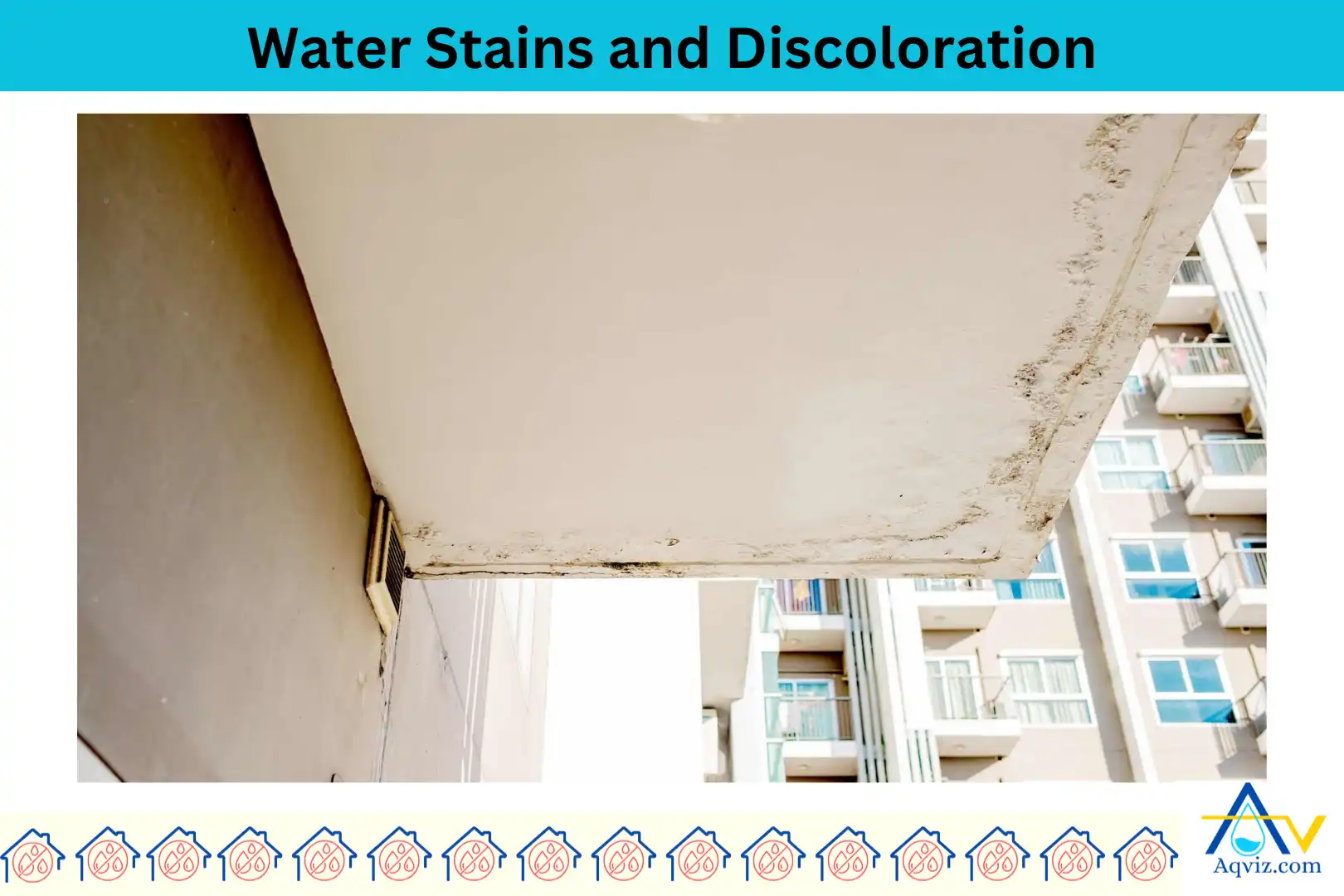What are the 7 Signs of Poor Balcony Waterproofing?

Poor balcony waterproofing is installing an inadequate or failed waterproofing system that allows water to penetrate the surface, causing damage to the balcony structure and potentially to the areas beneath it. This can result from improper installation, aging materials, poor drainage, or insufficient maintenance.
When a balcony waterproofing is damaged, it causes so many problems. The last 5 years Aqviz we, observed the below 7 signs are the most visible from the waterproof damaged balcony. We included details on how you can indicate it and in which areas you can see the problem.
What are the 7 Signs of Poor Balcony Waterproofing
These are the 7 signs of poor balcony waterproofing
- Water stain and discoloration
- Paint peeling or bubbling on the balcony surface
- Mold and mildew growth on balcony
- Efflorescence on balcony surface
- Cracks in tiles or grout
- Standing Water on the Balcony
- Damp or rotting balcony wood

1. Water Stains and Discoloration
We noticed this is the most common sign of waterproofing damage on the balcony. So if you see the below signs in your home check in depth.
Water stains are one of the first signs of waterproofing failure on a balcony. These stains appear as dark patches, yellowish marks, or white chalky residue. You’ll commonly find them on the balcony floor, walls, or ceiling of the area below. They indicate water seepage through the surface layers, which can lead to further damage if left untreated.
Water stain marks on the balcony clearly visible in dry days in a light background. During wet it is a bit invisible. So we recommend you check it on dry days.

2. Paint Peeling or Bubbling on the Balcony Surface
When balcony waterproofing fails, moisture seeps into the balcony’s surface. It cause to lose adhesion the paint. This results in peeling, flaking, or bubbling paint on balcony surface. You’ll often notice this on balcony walls, railings, or even the underside of the slab. It’s a clear sign of trapped moisture, which can lead to further deterioration if not addressed on time.
According to Aqviz’s investigations, we could find that the main reason is water due to waterproofing damage but there are more reasons for balcony paint peeling . So you had better check in in depth for this matter.

3. Mold and Mildew Growth on Balcony
If your balcony has waterproofing issues, you might notice black, green, or white fungal patches on the walls, floor, or even furniture. These growths not only damage surfaces but also pose health risks, causing allergies and respiratory issues. Persistent mold is a strong indicator of excess moisture that needs to be addressed immediately.
If you feel muddy or abnormal smell in your balcony or feel any allergies there, the main reason is mold and mildew growth in the balcony. Mold and mildew mostly grow in damaged waterproofing layer.
4. Efflorescence on Balcony Surface
According to our investigations, efflorescence in the balcony is rare. Because it depends on the structure, material also. You can see efflorescence in the balcony if the structure material is more porosity.
Efflorescence appears as a white, powdery, or crystalline deposit on the balcony floor, walls, or joints. It forms when water seeps through concrete or masonry, dissolving salts that later surface as moisture evaporates. This is a clear sign of continuous water infiltration, which can weaken the structure over time if left untreated.
5. Cracks in Tiles or Grout
Cracked tiles or damaged grout lines are strong indicators of balcony waterproofing failure. Water seeps through these cracks, reaching the underlying layers and causing further deterioration. Over time, moisture weakens the adhesive bond, leading to loose tiles or even hollow sounds when tapped. This can escalate into structural damage and costly repairs if you ignored.
6. Standing Water on the Balcony
Pooled or stagnant water on a balcony is a major sign of poor drainage and waterproofing failure. This happens when the surface lacks proper slope, drainage outlets are clogged, or waterproofing layers are compromised. Standing water accelerates material deterioration, promotes mold growth, and increases the risk of leaks into lower levels. If left unaddressed, it can lead to long-term structural damage.
Read more about: Balcony Standing Water Including Reasons, How to Fix it, and Impacts

7. Damp or Rotting Balcony Wood
Wooden balcony surfaces, railings, or support beams can absorb moisture if waterproofing is inadequate. Over time, this leads to swelling, warping, and eventually rot. Signs include soft, spongy wood, dark patches, or a musty smell. If left untreated, rotting wood can weaken the structure, posing safety risks and requiring costly replacements.
We observed this, and this is happened due to prolonged waterproofing damage. When the water leak occurs overtime, wood can rot easily. This can be increased if the wood is not protected by the coating.
How to protect Balcony Waterproofing Membranes?
After investigating the water damage signs, we could find what are the steps we can take to protect the balcony waterproofing membrane . Here is our steps and you can take these actionable steps to protect the balcony from water.
- Keep balcony floor drains, scuppers, and gutters clear to prevent water buildup.
- Do not place excessive weight, such as heavy planters or furniture, directly on the waterproofing membrane in the balcony.
- Apply UV-resistant sealers or wear-resistant topcoats on balcony walls to prevent degradation.
- If the balcony is tiled, reseal grout lines periodically to prevent moisture penetration.
- Do not use abrasive cleaners or harsh chemicals that can degrade the waterproofing layer in the balcony.
What are the Causes of Damage to a Balcony Waterproofing Layer?
A balcony waterproofing layer can be due to these reasons such as
- Poor waterproofing installation in the balcony
- Lack of proper slope in the balcony floor
- Expose the balcony surface to sunlight, including UV light
- Thermal expansion and contraction of the balcony structure
- Heavy foot traffic on the balcony
- Using harsh chemicals on the balcony flooring
- Cracks and damages on the balcony floor
A damaged waterproofing layer can be repaired by using a How to Waterproof a Balcony? guide. It includes all the step by step guide from start to finish.
Can Waterproof Balcony Floorings Protect the Damaged Balcony?
Waterproof balcony flooring can help protect a damaged balcony by providing an additional layer of defense against water infiltration. However, it’s essential to first address the underlying damage to the existing waterproofing membrane. If the membrane is severely compromised, simply adding waterproof flooring may not fully resolve the issue.
